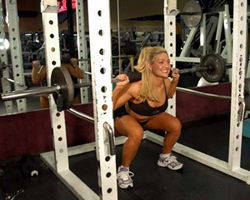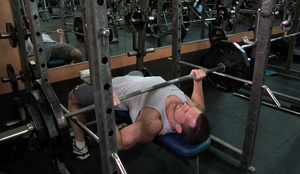A power cage is a popular piece of weight training equipment that is mainly used as a convenient workout station for freeweight barbell exercises. In the last couple of decades it has become more and more common in both commercial gyms and home environments. It is also commonly called a power rack or squat rack, although squat racks often mean a smaller, open unit.
The primary purpose of a power cage is as a passive safety enclosure for the barbell, allowing you to do barbell movements without restriction in your range of motion while having something there to catch the bar if if you lose balance and are in danger of having the loaded bar come down on top of you.
While you’re doing the exercises, the cage does NOT touch the bar at all. It is completely free. This is in contrast to a Smith machine, which holds the bar in a fixed plane of motion, with the carriage rolling on bearings, and does not require you to balance it at all. A power cage therefore gives you the full advantage of having a pair of friends on either side of the barbell spotting you, but better, because steel is more dependable than friends who can get distracted when their attention is needed the most.
It’s constructed with 4 upright steel tubes surrounding the barbell, so that it can only fall so far forward or backward, and two safety bars underneath the barbell that will catch it when it falls far enough. The height of the safety bars are adjustable. A bar of “J-hooks” or bar holders are set higher up on the cage, also adjustable height, to hold the bar between sets and allow you to load and unload the plates.
A pull up bar is always included as well, since something has to be up there anyway to connect the uprights together. On higher end cages the safety bars and/or J-hooks are plated with UHMW plastic, a very hard material that won’t crack under shock loads and is made to protect the bar from steel-on-steel contact and reduce noise. Power cages can come with various accessories, such as plate storage posts on the rear, handles for doing dips, extra J-hooks to place facing outside the rack, and a few other things depending on the specific brand and target market. You can also buy other accessories separately, such as a weighted dip belt for use with the dip bars or pull up bar. And of course you’ll need a bar and weights.
Variations in the basic design of the rack include different sizes and gauges of steel and different heights. Heavier and taller is great, but for many users there’s a limit as to how heavy-duty they want to go, due to cost and the possibility of having to move it someday.
And of course you’ll need a bar and weight plates to actually use the rack (other than use the pull up bar). It is made to take a 7ft bar, so that the inside collars are outside of the bar holders and safety bars and there’s no interference when you want to load plates. Technically a 7ft standard bar (with 1″ diameter ends) would work, but people almost always use an olympic bar (2″ diameter ends), the most popular type today by far.
We have put together a comparison of the best freestanding power cages so you can understand the differences and quickly select the one best for you.
We hope this description gives you a better idea of what a power cage is, or what a cage is used for, and why you might want it for your home gym. Males and females alike benefit tremendously from having this piece of equipment to use.


